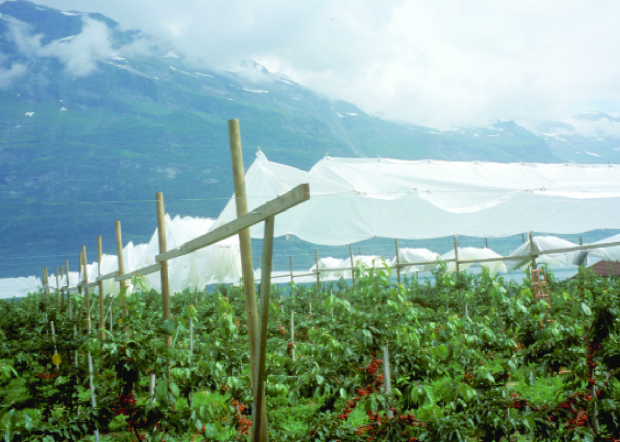
The three-wire system used in Norway allows the plastic sheeting to be moved away if desired.
Norwegian growers are blessed with growing conditions favorable to cherries—except for frequent summer rains. Covered systems are widely used there for protection from untimely weather. Almost all cherry orchards in Norway are covered for rain protection, according to Dr. Mekjell Meland, scientist at the Norwegian Crop Research Institute in Lofthus. “You have to have covers if you want to stay in business.”
Fruit orchards in Norway are small, family-run farms, averaging two to seven hectares, with one to two hectares in cherries. One hectare equals 2.47 acres. Tree fruit are grown on steep, sloping lands. The 60° latitude of Norway also crosses Anchorage, Alaska. Workers from eastern Europe harvest the pedestrian-style cherry orchards. Van is the main cherry variety grown; others include Burlat, Lapins, Ulster, and Merchant. Aside from the summer rains, the climate in Norway generally provides good tree fruit growing conditions.
The fruit-producing region does not have damaging winter frosts. Spring frosts are rare, and summer temperatures are low but sufficient for good quality fruit. “Rain in the summer is the problem,” Meland explained during his talk on cherry covers at the International Dwarf Tree Fruit Association meetings recently held in Washington State.
Covered systems
Meland began studying covered orchard systems several years ago. “We can’t grow cherries in dry areas, and calcium chloride hasn’t worked in our environment,” he explained. They first tried umbrella-type covers over each tree, which were not especially successful. Temperatures within the umbrellas were higher than outside air temperatures, and the covers were very labor intensive.
Covers were then modified by running a single wire down the middle of the tree row, with the plastic sheeting tied down on the sides, similar to a simple tent. The system was further refined and developed, with three wires found to be the most successful. Cross-arm supports are placed at the ends of the tree row, with the movable covers attached to three wires. The covers can be pulled out of the way if desired. By connecting the covers to the side wires with rubber bands, he said that the system has elasticity and can take wind speeds up to 20 meters per second (44 miles per hour), adding that plastic connectors also give needed elasticity.
Growers usually leave the covers up once fruit becomes red and is susceptible to cracking. Though they rarely have strong winds, the covers can be opened if winds threaten the integrity of the covers. Through trial and error, they have reinforced the end supports of the cover system to provide more strength and wind resistance. Different types of plastic sheeting have been tested. A polyethylene ultraviolet-stabilized material was found to be the most successful.
In studies, the temperature difference between covered and open trees was insignificant. Norwegian growers pay less than $1 per square meter for the cover system. It is flexible enough to be useful in small growing areas, even on hillsides. Netting can also be put over the top of the sheeting to provide complete protection from birds.
Other systems
Meland is testing a new cover system from Germany called the Voen. He is excited about the structure that provides rain, bird, wind, and hail protection. “The system is a different concept from the one we use in Norway,” he said. “It has a frame with metal posts, wires, and the plastic comes in two parts. Netting is connected on the sides of the plastic. That means that part of the plastic can move when the wind comes in.”
The Voen system is much more expensive than the three-wire design, costing about three times as much, but the trees are completely protected. Many types of cherry cover systems are sold in Europe, he added. Some use a hoop or bow to support the covers, several are designed like tunnels, and some are permanent structures similar to greenhouses. He cautioned that growing cherries under tunnels is different than using rain covers.
Different types of plastic can manipulate the climate inside, resulting in early or later ripening dates. “You can modify the environment inside with the tunnels. Growers need to learn how to grow cherries under tunnels.” Meland found the most sophisticated use of covers in Holland. An old tomato hothouse was converted to a greenhouse for high-density cherries grown on Gisela 5 rootstock. Root pruning was done to help control tree vigor.
Bees
Meland stated that most Norwegian growers don’t put the covers up until after bloom, due to concerns about pollination and bees. “I’ve told the growers that they can put up the covers during bloom to save on sprays, but they don’t do it.
They like it open for pollination. I know that bees and covers can be a problem.” Growers using tunnel systems often put in bees for insurance. “I saw that in South Africa, where they are growing dwarfing trees and investing in tunnels, that the bees were confused under the tunnels. It’s something that you must watch for.”






Leave A Comment